AMAZON’S IMPENDING TAKEOVER: The One-Stop Shop for Smart Cities with Digital Currency Control
Sun 9:45 am +00:00, 16 May 2021This sounds like a dystopian science fiction movie, but unfortunately, it’s already in the works, they are just putting the final touches on their master plan. A “smart city?” The only shop for products, food, and healthcare while tracking us? A biometrics palm scanner? All autonomous vehicles and public transit? No more cash or credit cards – all digital currency? The ability to freeze our accounts or prevent us from purchasing certain items? Does this sound crazy? It should! Let’s take a look at the rollout and possible ways to navigate and combat some of this.
Amazon’s been quite busy progressing in areas most people are unaware of. This goes far beyond taking out the little guys – they’re going for the middlemen, and heading straight for your family. How are they pulling all of this off?
Don’t miss our weekly Dig It! Podcast on April 23rd where we discussed several of the details in this report.
Amazon’s “Takeover” Consists of 3 Stages, In A Nutshell:
Stage One: Obliterate the competition by taking over the organic food market, media, crushing all bookstores to control content, provide nearly every consumer product and get others to sell through your shop, and beefing up production with expedited shipping to make it so desirable, no one can compete, and everyone comes to rely on Amazon.
Stage Two: Capitalize on an event that demolishes small businesses, demolishes remaining competition, crushes the farming industry, increase service by billions while people are stuck in their homes, and consolidate power forces to takeover other markets. Produce drones for delivery and autonomous cars for getting around smart cities. Create blockchain and step up air freight to soar past the delivery competition. Make all of it sound like you are saving humanity during hard times.
Stage Three: Continue to expand products and services, add a healthcare division, grocery delivery, implement digital currency, expand the AI division, then step down as CEO to focus on the final stages of the agenda.
What the Heck is A “Smart City?”
“Smart Cities” and “smart growth” are the talk of the town among the so-called elite, philanthropists, mayors, and of course the UN. They want you to believe they are creating ultra-convenient cities where everything you need is at your fingertips. That’s right – smartphones, smart cars, smart public transportation, smart shopping, smart TVs, smart health – you name it, AI is here to save the day and track you all the way. This is neither myth or fantasy. In fact, the infrastructure has already begun in your city, long ago.
Is Amazon Part of The “Smart City” Plan?
You betcha! Apart from all of their “smart” (spying) devices to fill everyone’s “smart homes” in their “smart cities,” their AWS cloud is high on their list, as noted on their city transformation page: “Public sector innovation is moving faster than ever before, delivering cloud-connected thinking that is revolutionizing cities across the world. Harness the power of Internet of Things (IoT), machine learning, artificial intelligence, and more.” They talk about how the “smart city” and community environments will involve connecting “smart devices” and systems in sectors such as transportation, energy, manufacturing, and healthcare in fundamentally new ways that will “enhance the quality of life.” Be “smart,” and don’t be fooled.
Here is a short clip of Bill Gates talking about it a few years ago, but the plans began decades before. Whether or not Gates plans to build a “smart city” on the land he purchased in Phoenix is irrelevant, because they are already underway in thousands of cities across the country and the world. Keep your eyes open for Corey’s Digs report coming out in the near future, on this specifically, with detailed instructions on “OUTsmarting” them.
How Are They Going to Create a Cashless Society and Switch to Digital Currency?
This isn’t a matter of “how,” but rather, a matter of “when.”
Anyone paying attention to the financial market is aware that this is already well under way. Jerome Powell, chair of the Federal Reserve, just told congress in March “This is going to be an important year. This is going to be the year in which we engage with the public pretty actively, including some public events that we’re working on that I’m not going to announce today,” referring to digital currency, and stated that the Fed will need “legislative authorization” to proceed with the digital dollar. It’s also no secret that China is producing their own digital currency, have been testing it in four major cities, and it is projected to eventually replace cash.
Mastercard and Visa recently announced they will be accepting cryptocurrency or Bitcoin this year. “We’re trying to do two things. One is to enable the purchase of bitcoin on Visa credentials. And secondly, working with bitcoin wallets to allow the bitcoin to be translated into a fiat currency and therefore immediately be able to be used at any of the 70 million places around the world where Visa is accepted,” said Al Kelly, the CEO of Visa.
Over 15,000 businesses, and climbing, accept Bitcoin, while Bank of America and other banks are working on something outside of Bitcoin. As of March, roughly 86% of central banks are in the development stages of forming their own “central bank digital currencies.” Forbes reported that Macquarie Capital analysts said the Federal Reserve and ECB could debut their own CBDCs as soon as next year, as governments ramp up regulation in the space that discourages consumers from embracing other tokens–a move the analysts say could lead to crypto prices tanking below current levels.
What some people may not be aware of, and seems to be flying under the radar, is that Amazon appears to be working on launching their own cryptocurrency. In 2019, Amazon began buying up cryptocurrency-related domain names. Whereas that brought on a lot of speculation at the time, it seems that Amazon may in fact be launching their own cryptocurrency. Over the past couple of months Amazon has been posting job positions for digital currency-related positions for a potential pilot program in Mexico, which they refer to as “Digital and Emerging Payments (DEP).” Some of the job postings have since been removed, but Corey’s Digs has archived two such positions, and a few can still be found on Amazon’s site here by searching DEP. Interestingly, one of the positions is through Amazon’s Asia Pacific emerging market payment business where they are seeking a Finance Business Partner/ Senior Financial Analyst.
How Can They Prevent Us from Access to Our Own Digital Currency?
It’s quite simple. In fact, it’s already been happening, and it’s very easy to do. Numerous people have already had their Paypal accounts shut down, or Patreon, Etsy, and even bank accounts, all because they used their voices to express their opinions on political events happening in our country. They prevented people from access to their funds, from being able to spend money or in some cases – earn a living. Amazon has removed some sellers’ books and accounts entirely because they didn’t want information getting out to the public on specific topics that went against their narrative. How’s that for control?
You’ve already seen in the previous section that they want full control of this, and anyone who is familiar with the UN agendas and China’s social score system, understands that once we become a cashless society, and everything moves to digital currency, it’s a simple stroke of the key to prevent us from access and or purchases.
Have you ever tried to make a purchase on your credit card and the cashier informed you that “your card didn’t go through?” You called your bank, furious because they had put a cap on a purchase amount and had to lift the limit in order to complete your purchase? Now imagine if the “cap” was because you didn’t do as told or spoke out when you weren’t supposed to and suddenly you can’t purchase groceries or have access to various establishments. Preventing access to establishments is already happening with the Covid vaccine. This is a training ground they are prepping you for.
How Could Amazon Possibly Be The Future One-Stop Shop?

It’s so easy. Offer damn near every product and service man needs or desires, flood the market with your logo and pop-up ads, provide free shipping, and get them the products in 1-2 days, making it so convenient that everyone becomes hooked. It’s the one-stop shop. Once they are sucked in, demolish the competition and add all other services you want to control people through, such as food and healthcare. Entice sellers and affiliate marketers to ride the train and make money from it, and you’ve created a masterpiece!
Since its inception, Amazon has acquired over 100 companies, has stakes in dozens of others, and its sight set on more acquisitions in the future.
The year 2020 took a huge toll on small and medium-size businesses all across the country who were told they were “non-essential” and had to close their doors, while Amazon’s sales increased by 38%, raking in $386 billion dollars. Coincidence, or by design? Be “smart” now.
So how does all of this relate to the future of “smart cities?” Simply put, they want everyone and everything wired in, hooked, tracked, and controlled. Truth be told, artificial intelligence and robotics is not for convenience, efficiency, sustainability, for healing people, or any other fallacies they allege. Their ultimate desire is transhumanism, and they don’t hide it. To be immortal is a long-held goal of theirs.
For years, billionaires have been investing in biotech companies for “longevity,” including Jeff Bezos. “The proposition that we can live forever is obvious. It doesn’t violate the laws of physics, so we can achieve it,” Arram Sabeti told The New Yorker. Microbioloist Brian Hanley claims “There’s a bunch of things that will need to be done to achieve life spans into at least hundreds of years. But we’ll get there.” Bezos invests in Google’s billion-dollar Calico longevity lab, and more recently funded $76 million to a biotech company studying the body’s full set of proteins.
When reviewing the list of Amazon’s one-stop shop making its way down a highway, straight into your smart city home, keep all of this in mind.
Amazon One

Who says we need a microchip when biometrics is already in action? Amazon is way ahead of the curve with their fancy palm reading machines (and not the fun kind from a psychic), with 11 locations already utilizing them in Washington state.
Step right up with Amazon One and simply “hover to enter, identify, and pay.” Just like that! Their goal is to “unlock your world by giving you the freedom to pay, enter, and identify with nothing but your palm.” Isn’t that generous of them?
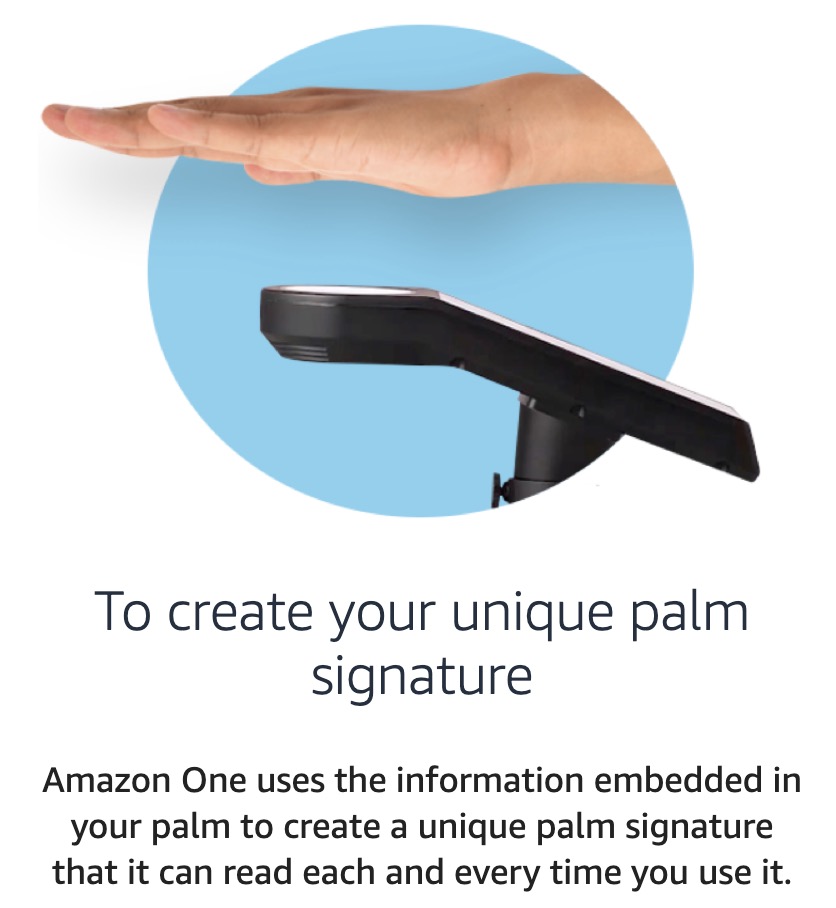
Just remember, “your palm, your choice.” Yes, that is an actual slogan on their marketing page. How does it work? Easy peasy, just take a look, and remember… your “data is protected every step of the way.” So your palm print, identity, credit card, contact information, purchases, and so much more is safe with Amazon. No worries.
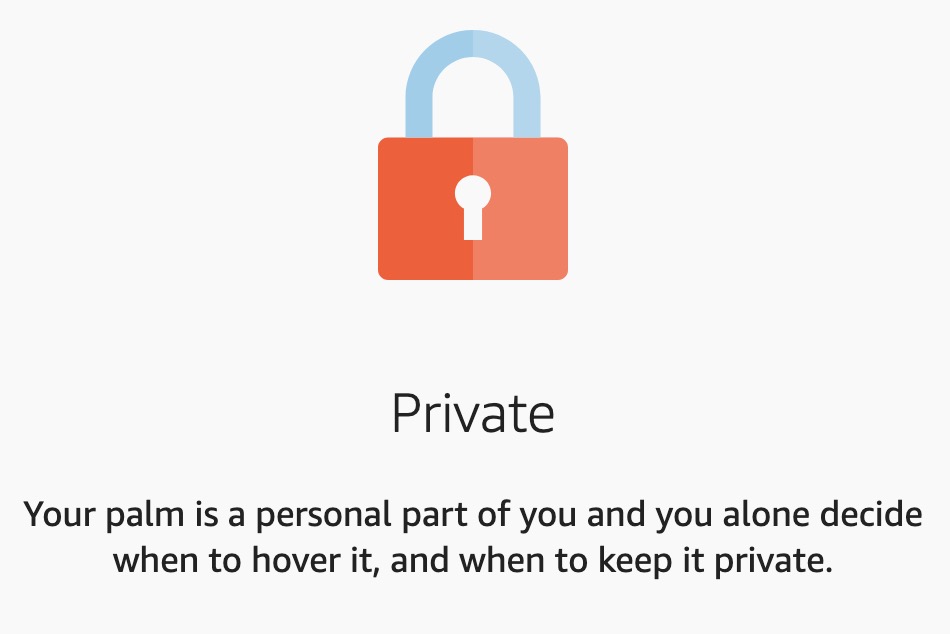
I realize this is a serious piece but there is so much comedy to be had in the above sentence, I’m finding it hard restraining myself. Who manages their PR? I mean, how much thought went into this little marketing piece? “You alone decide when to hover it,” because in the near distant future someone may be grasping your wrist and hovering it for you so they can obtain access to all of your bank records. Mwahahaha! But on a more serious note, think about that for a second. Whether you are “hovering” your palm for biometrics or a microchip, how easy would it be to force someone’s hand over an ATM say, that is unmanned? We are entering a whole new level of thievery with this futuristic virtual world they desire. But, they’ll play it off as “convenience” and the young, the naïve, and the lazy will eat it up.
Speaking of microchips, 60 Minutes recently spoke with DARPA regarding their “new” subdermal implants that can allegedly detect if your body is coming down with Covid before symptoms arise. Just a quick scan over a device and it can break down all of the details. They’re allegedly in the “late stages” of developing this for the military. But don’t worry, Bill Whitaker tells us this “monitoring” device is not some “dreaded government microchip to track your every move.” It’s reminiscent of Bill Gates giggling about the “conspiracy theory” of microchips not long ago. I guess DARPA let the cat out of the bag.
Digital Currency
How will you pay for all of these smart devices, products, and services below, aside from “hovering” your palm?
Amazon’s new digital currency, of course! They are in the process of getting it up and rolling, so by the time the smart cities welcome you with open arms, you’ll be ready to rock n’ roll! And if that fails, rest assured, the central banks are all working on it as well.
“Smart” Devices & Spyware
These are just a few devices in how they monitor your moves and words to capitalize on them, point you in the direction they want you to go, and control you through digital currency.
Who could resist all of the fancy, smart device spyware in a smart city? First there was Alexa, then there were smart devices with her voice amplifying everywhere, and now Amazon is thinking about reentering the smartphone market once again. Hop on over to their “Smart Home” section for all of the newest goodies, such as smart lighting, locks, security cameras, detectors and sensors, voice assistants, even a new Alexa ceiling light with wifi – be sure to put one in every room for full spying capabilities, plus so many more “smart” devices for the lazy at heart.
Just wait until some of these features are automatically installed in micro units people will be living in. You think I’m kidding? Lennar, the nation’s largest home builder began installing Alexa smart devices, under their “Life Reimagined – Everything’s Included” package, in all of their new homes, back in 2018. In 2019 they did $20.5 billion in sales. All homes include built in wi-fi, smart locks, ring alarm security system, doorbells, thermostats, garage control, and lights – many of which are controlled by Amazon Alexa’s voice-activated digital assistant, because you know… God forbid someone has to get up to change the thermostat. Self-enslavement is quite something to observe. People think it’s the greatest thing since sliced bread, until they realize they are being spied on and prepped to relinquish all control. Privacy will be non-existent and choices will be removed.
How soon before Alexa becomes a full-bodied robot? In 2019, Amazon’s head scientist Rohit Prasad suggested that “in order for Alexa to live out its artificial intelligence truth, it’ll need a fully functioning robot body…the only way to make smart assistants really smart is to give it eyes and let it explore the world.”
The Food Industry

Aside from all of the spyware and biometrics, the food industry is by far the most critical when it comes to survival, and it sure seems that Amazon is on track to take full control of the food industry, and this doesn’t even include the fact that his buddy Bill Gates has bought up over 242,000 acres of farmland in the US.
There are 10 companies that control nearly everything we buy when it comes to food and beverage as well as some other products, all of whom sell products on Amazon. As of 2020, Amazon dominated the top retailers of food and consumables category, alongside Kroger and Walmart.
Who is the world’s largest food and beverage company? Nestle. While Amazon’s sales increased 38% during 2020, Nestle’s e-commerce sales increased 48%, making up for 12.3% of their total sales. They have their Covid agenda to thank for that.
In 2017, Nestle announced it would be opening a dedicated office in Seattle with a “global Amazon acceleration team” to grow Nestle’s e-commerce operations. The building permits list tenant improvements for “Nestle Amazon.” Unilever, Colgate-Palmolive Co., and other suppliers are already setup there.
In February 2019, Nestle signed a lease on a 47,500 sf office space located at 450 Alaskan Way South in Seattle, located just 8 minutes from Amazon headquarters, and 14 minutes from Evergreen Point Rd where Bill Gates, Jeff Bezos, and Microsoft execs reside in Medina. The lease came after Nestle struck a $7.15 billion deal with Starbucks to sell their products. The building is also home to Saltchuk’s new headquarters. They are one of the largest private companies in the US, providing marine services, trucking, petroleum distribution, air cargo, domestic and international shipping and logistics.
Nestle is excited to be a part of Amazon Managed Blockchain.
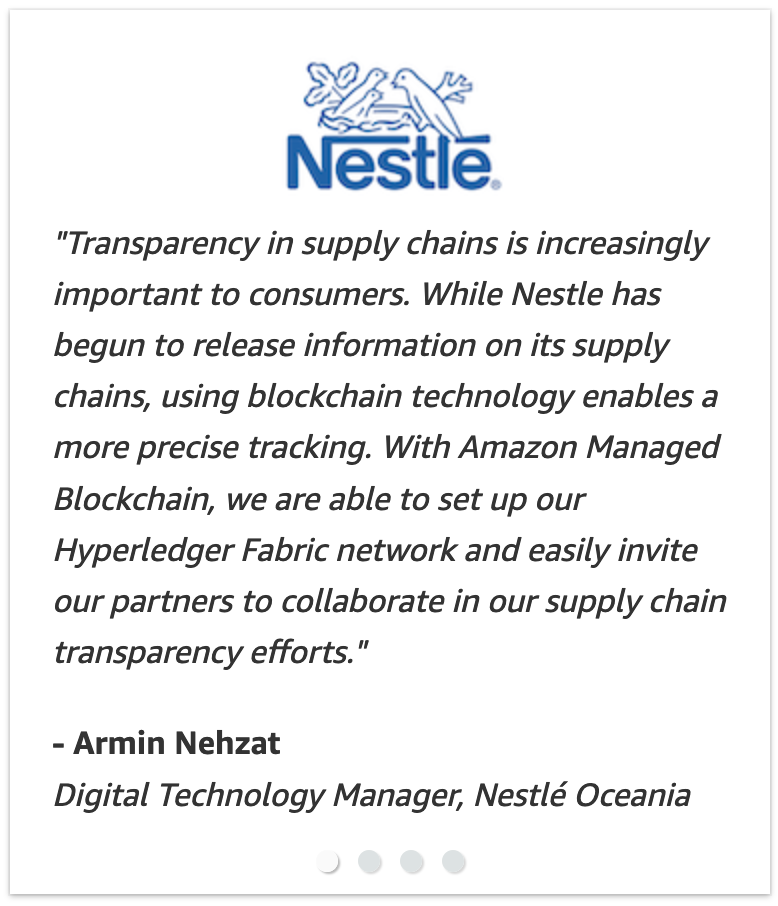
Just last fall, Nestle acquired Freshly Inc. and recruited top Amazon executive Anna Fabrega as chief commercialization officer.
Weeks ago, Nestle announced their new UK digital distribution warehouse of the future with sophisticated robotics, sustainability in mind, and a liquified gas refueling station for energy efficient gas trucks. The warehouse is located on a railhead, so it can deliver into the London area via rail, which is where Amazon UK’s headquarters is. Nestle suggests using Amazon or other online sources to find a specific Nestle product that you might not be able to find in your country.
While they may talk about their concern for sustainability and the environment in the UK press release, they don’t seem to share the same concern for a treasured natural spring along the Santa Fe River near Gainesville, FL. Despite protests and over 19,000 written public comments opposing it, Nestle just got approval to tap 1 million gallons of water per day to produce their bottled water to sell back to people. At least seven of their water brands are sold on Amazon. Activists and environmentalists are concerned that the river and network of springs are already taxed. The battle continues.
When Amazon began venturing into the food and grocery industry, my first thought was… how are they going to take out the middlemen – the foodservice distributors – all 16,000+ of them? I began running scenarios in my mind and could see how this would happen in time. They would pick off the smaller ones first, they would make it difficult for the mid-size ones to compete, then they would either acquire the larger ones or allow one or two to survive if they needed them in specific regions. After all, their own distribution infrastructure is already in place, and as they buy up, build, and invest in grocery stores, the shift would present a huge challenge. I began to dig a little and found that there are only 8 major foodservice distributors that make up 41% of the market, leaving a huge 59% for Amazon to steal. Sysco, a global foodservice distribution company that distributes to 90 countries, is now using Amazon’s AWS services to reduce its storage costs.
What happens to the Walmarts, Costcos, and major grocery chains such as Kroger or Publix? I suspect that some of them will be allowed to stick around. Whereas each smart city may eventually consist of an Amazon Fresh and/or Whole Foods, some of these other establishments are already well positioned in smart cities and deal directly with the manufacturers. That said, many smaller grocery stores will likely fold because they can’t compete with the new e-commerce and distribution methods. What about Uber Eats, Grubhub, or DoorDash? It is my opinion that they will be around for awhile because it helps to breed a new culture of “food delivery,” but once those autonomous vehicles, drone deliveries, or the Amazon Scout are revved up, people won’t be needed for deliveries. I believe this will be the case with Instacart as well in the long run.
Whole Foods
Amazon’s growing food market extended offline when they purchased Whole Foods in 2017 for $13.7 billion. There are a lot of important details people are unaware of when it comes to the “organic” food industry, Whole Foods, and Amazon’s acquisition of it. There is much more to this story. I wrote an article about this in 2018 titled ‘The Organic Narrative & Whole Foods Red Flags.’
Amazon Fresh
You can order directly through your smart devices in your smart home, via Amazon’s digital currency and get your groceries delivered to you the same day, right from Amazon Fresh! Some cities in California and Illinois already have an Amazon Fresh store in their area, so you can shop in person. And hey, why wait at the deli counter when you can use the Amazon app to order ahead, or use the Amazon Dash Cart with a checkout process right on your “smart shopping cart” that has sensor fusion and vision algorithms built in so you can just roll out through the sensors and it charges your credit card on your Amazon account. See how convenient and enticing this is, and how well it will work with digital currency?
Now imagine walking your cart through the sensor, as you head for the door, and suddenly the alarms go off (like in a retail store when they forgot to remove the tag), because you didn’t get your annual vaccine, or you were naughty on social media. When this happens, just meander over to the Alexa stations where you can have a conversation with AI. Instead of asking where the ketchup is, give her a piece of your mind! I recently yelled at a robot on the phone when it wouldn’t connect me to customer service. It didn’t help my cause, but it made me feel better.
Amazon Go and Amazon Go Grocery
Amazon Go is a breakfast, lunch and snack place where you use an app on your smart phone and scan it at the gate to enter. You then grab what you want off the shelf, can even put it back and grab something else, then walk out, and it’s all tracked. Amazon Go is currently located in Chicago, New York, San Francisco, and Seattle. Amazon Go Grocery is currently only located in Seattle and is a similar model to Amazon Go. They refer to these shops as “just walk out shopping” – while you are being tracked of course.
Healthcare Industry
Amazon Care
Who needs a doctor? Don’t you worry, Amazon’s got your back. They will send a doctor straight to your smart home in your smart city! They’ve got you covered with insurance, doctors, and pharmaceuticals through Amazon Care. The convenience is endless.
No need to revamp Obamacare, we have Amazon Care, and their care app will soon be outfitted with a vaccine ID passport, no doubt. The CDC recommends “virtual care” – it’s a perfect fit!
Pharmacy
You heard that correctly. Amazon can fill your prescriptions. No need to leave home. Just stay in your smart home, plugged into all of your smart devices, and if you want to get away or vacation, just hop on your virtual reality platform that is soon to hit every city, especially with 5G in full force.
Entertainment Industry and Narrative Control
What good would a one-stop shop be if they cannot control the narrative?
Prime Video – Stream Movies & TV Shows
A dishful of steaming movies and tv shows for your brainwashing pleasure. Don’t forget your Fire TV stick. Of course, they also produce their own originals through Amazon Studios.
Amazon Publishing
You can self-publish on Amazon via Kindle, paperback, or audio, but if your information doesn’t fit their narrative, expect to get the boot. As with all of their products, they take a percentage.
Amazon Books
They have physical locations in over 20 locations where you can purchase books and test drive Amazon devices and smart home accessories. Oh goody!
Kindle Fire
Get the smart Kindle Fire and get access to over 33 million movies, tv shows, song, books, games, and Amazon’s Underground app store with even more subliminal mind control and brainwashing media.
Amazon Music
Stream music all day long, with an app for your smartphone too!
Pet Food & Supplies Industry
Pet Food & Products
In 2018 Amazon launched a dog food and new pet products line. If they are going to takeover the market, they have to provide for the rest of your family. Just be sure to check those ingredients.
Shipping Industry and Robotics
Freight Shipping
Who needs UPS, Fedex, or DHL when you have Amazon Airthat can ensure your package arrives in under two days because they have over 35 hubs and gateways across the US? Just last month they opened a new hub in Alaska.
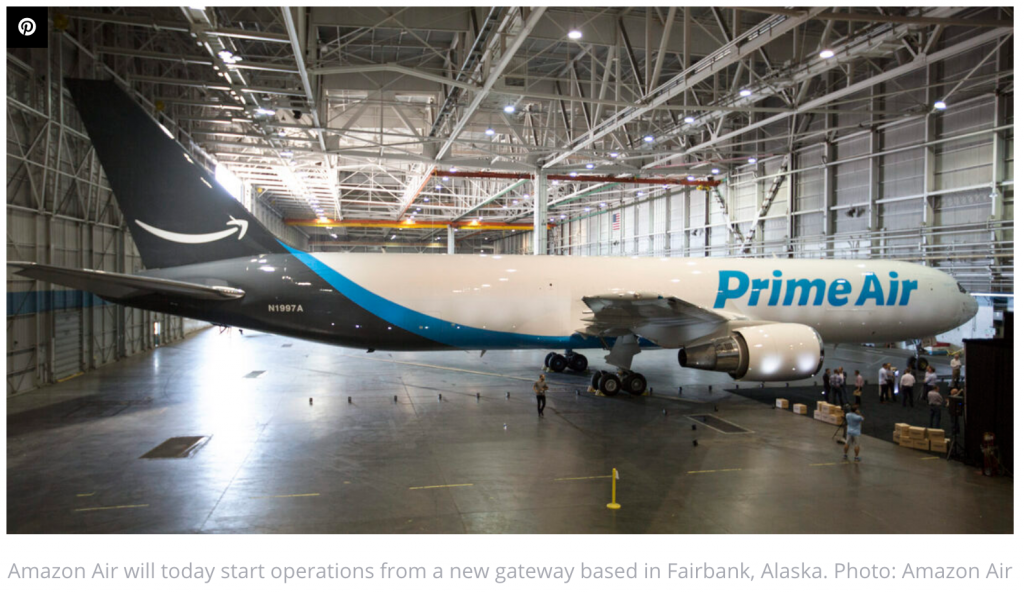
Amazon Air, formerly Prime Air, is growing so fast that it will double its daily operations by spring, running an average of 160 flights per day, and they plan to use drones for delivery. They’ve also setup new operations in Germany. Whereas Amazon used to lease planes, they are now buying up Boeings, ex-Westjets, and ex-Delta aircraft. It makes one wonder, as commercial airlines spiral downward, will Amazon scoop up their planes to expand their fleet and one day sink UPS, FedEx, and DHL? It fits with the rest of their storyline.
Amazon Delivery Drivers
Back on the ground, you’ve all heard Amazon’s obnoxious reverse sirens on their delivery vans, right? It’s enough to drive you crazy. Imagine being the driver who was recently told that they have to sign a ‘Biometric Consent Form’ or lose their job.
In February, Amazon announced that they would be installing surveillance cameras inside its fleet of vehicles, to surveil their drivers and alert them to poor driving habits. Of course, they allege that their “intention with this technology is to set up drivers for success and provide them support in being safer on-road and handling incidents if and when they happen.”
The Netradyne surveillance system, called Driveri, will monitor speed, hard braking and acceleration, seat belt compliance, failure to stop at a stop sign, a driver pulling out their phone, and will alert the driver while driving. The form requires that drivers agree to facial recognition and other biometric data collection, including monitoring the driver’s body and facial movements.
Amazon’s goal is to have a fleet of 100,000 electric delivery vans by 2030, equipped with Alexa, mapping systems, automated emergency braking, lane assist, automatic warning system that detects and alerts distracted driver behavior, and more slick features. They currently have them operating in some cities and anticipate 10,000 hitting the road by 2022.
Many drivers are leaving their job because of these new requirements. But this shouldn’t come as a surprise because Amazon doesn’t seem to have much respect for their employees, as was the case with their Amazon Flex division.
Amazon Flex
Amazon’s Flex division is for drivers delivering packages utilizing their own vehicles. Whereas they may not have the biometrics cameras, Amazon neglected to pay them their full tips for 2-1/2 years, and only began paying out once they realized the FTC had opened an investigation into them. This resulted in Amazon having to pay more than $61.7 million in charges which represents the amount of tips that Amazon withheld from drivers.
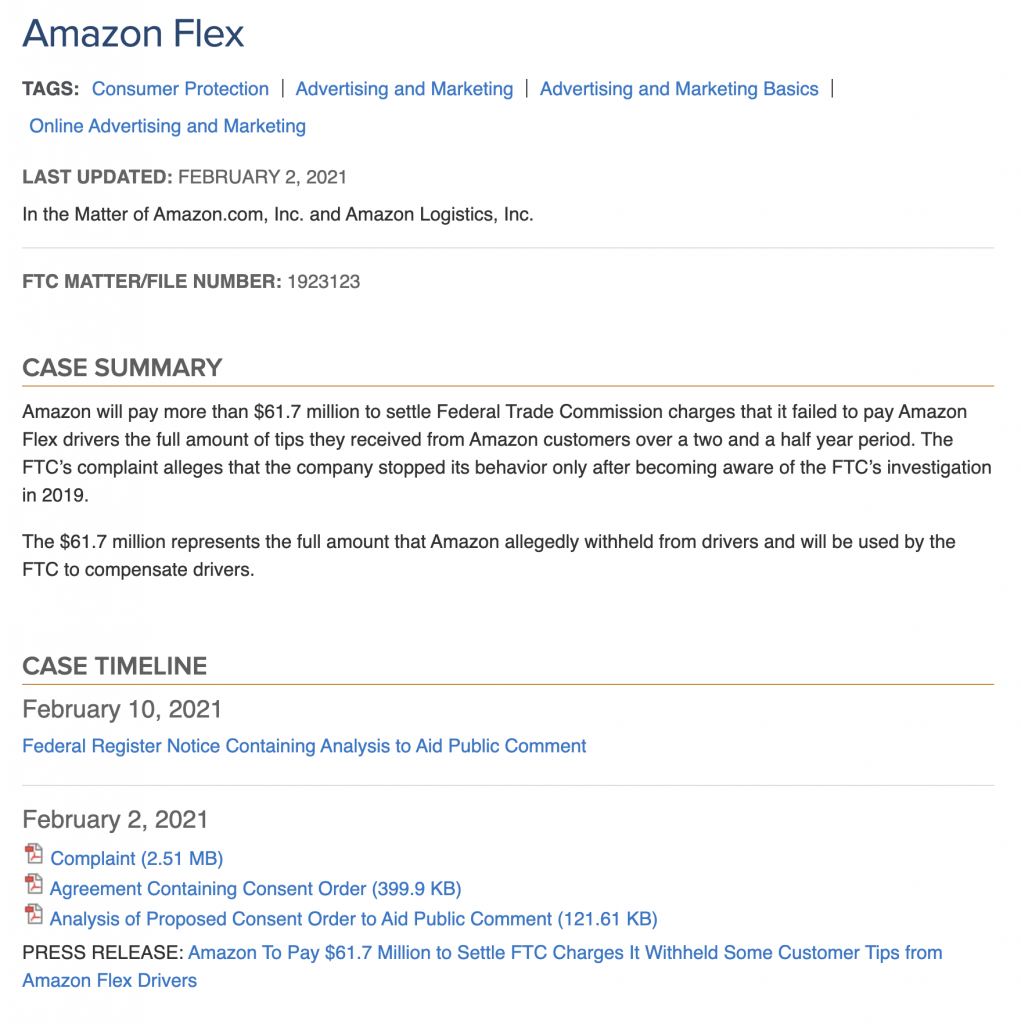
Drone Delivery
Why wait 3 days for UPS, or the immediate 24-hrs by Amazon’s regular delivery when you can get instant gratification by drone delivery? Especially if they won’t allow you to drive somewhere, right?
Drone delivery in just 30 minutes, with a click of a button, you can have a drone at your doorstep.
Amazon Scout
Another form of robotic delivery to reach Amazon’s goal for net-zero carbon emission by 2040. They plan to replace delivery carriers with Scout eventually. Imagine seeing these strolling down the sidewalks in your “smart city.” But don’t worry, Bezos ensures that AI and robots will not take away jobs from human beings. Ok, sure.
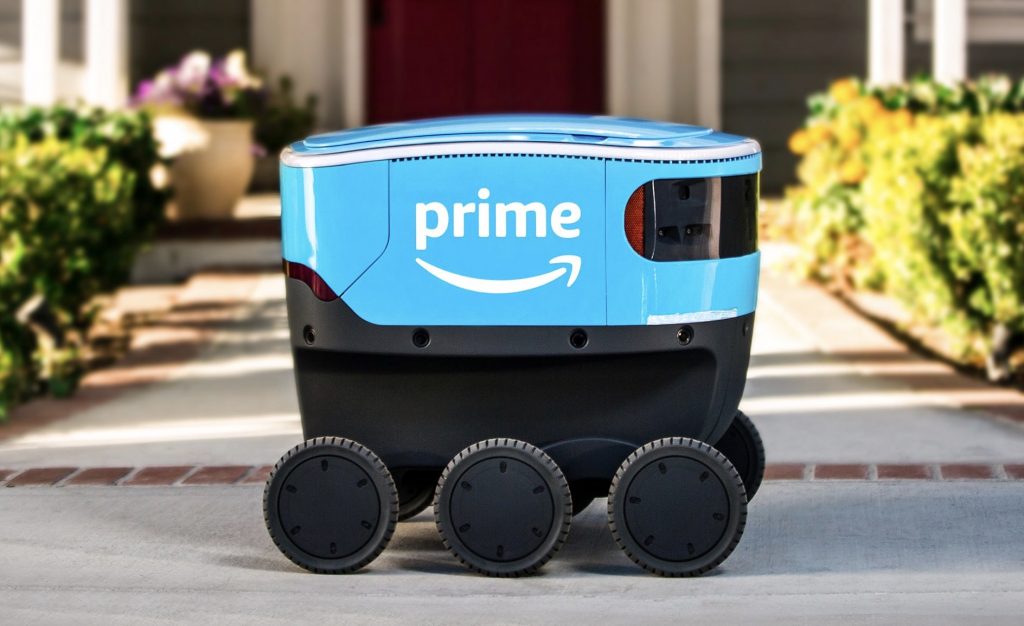
Amazon Robotics
Manufactures mobile robotic fulfillment systems.
Autonomous Passenger Vehicles
Why would you want your own vehicle so you can exit the smart city and drive across the country when there are autonomous cars that can take you within your limited 15-mile radius, or “brake” you when you’ve been naughty?
Meet Robotaxi, the cute little self-driving car by Amazon’s company Zoox that was founded in 2014 and acquired by Amazon in 2020. It can operate up to 75 miles per hour, and is designed for “dense, urban environments” (smart cities). It’s fashioned with 4 seats, no steering wheel, and a really big battery that allows it to run for up to 16 hours without a charge. Of course it’s equipped with cameras, radar, and LIDAR to scan the perimeter for pedestrians, and likely has some biometrics worked into it as well.
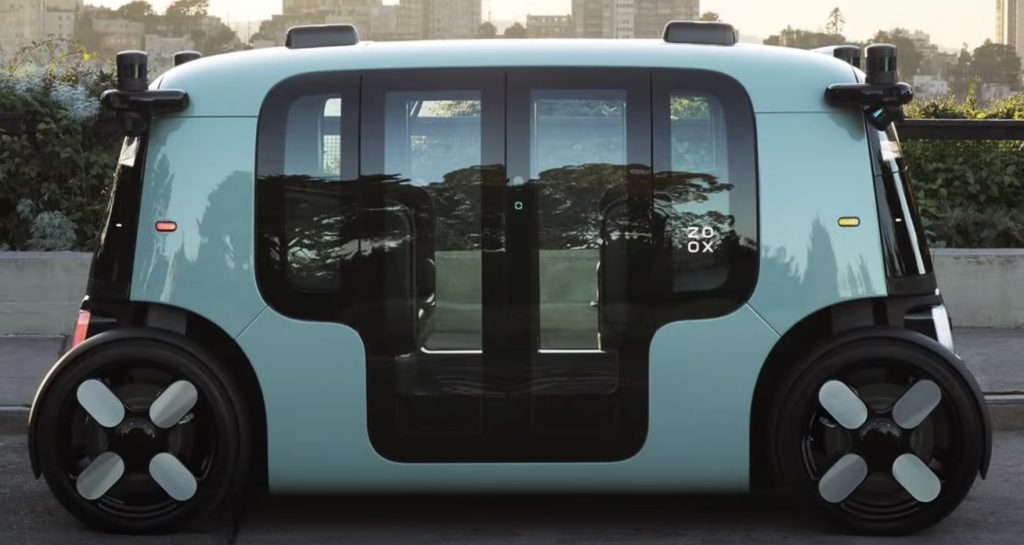
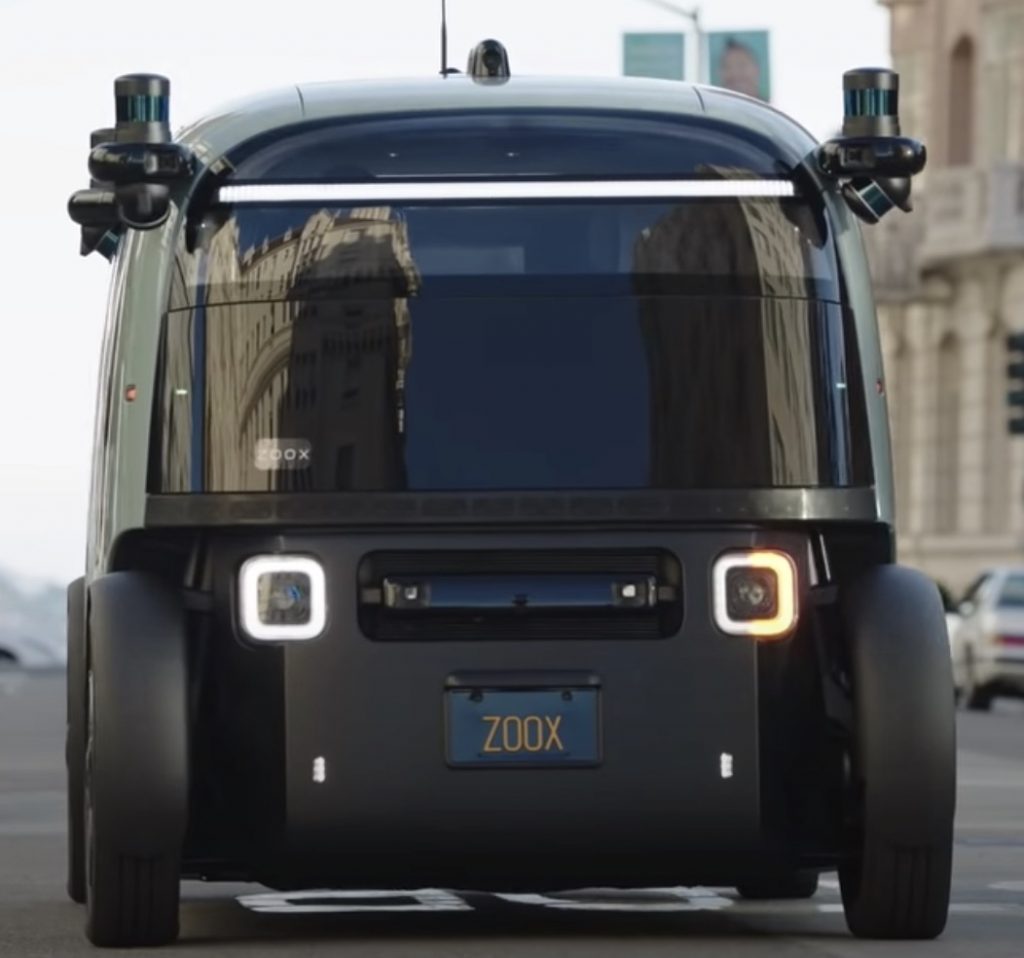
This adorable little monster is powered by NVIDIA DRIVE, who is also working with Volvo, SAIC, and others to reinvent the future of transportation and already have $8 billion in the pipeline over the next six years. Interesting shareholders.
Say goodbye to Ubur and Lyft, along with thousands of jobs. Who needs them when we have AI driving us to our “allowed” destinations – without a steering wheel?
Once they “move people” they will eventually “move packages” as well.
Watch this short video from the Zoox CEO explaining how you will ride in the Robotaxi, how they will charge for rides, and why it’s so necessary to have autonomous vehicles.
Corey’s Digs recently published an article on the future enslavement via autonomous cars. Whereby, the powers that be allege it’s all for sustainability and to save the climate, they fail to explain the lithium batteries required in these vehicles and what will happen as more lithium continues to be mined. It also provides information on the transportation department, funding, and legislation in place to push this agenda forward.
Renewable Energy
Jeff Bezos is big on renewable energy projects, including his Breakthrough Energy Ventures group with Bill Gates, Michael Bloomberg, Richard Branson, Jack Ma, Reid Hoffman, and over a dozen others. Amazon currently has 206 wind and solar projects rolling worldwide, and are now “the largest corporate buyer of renewable energy in Europe and globally,” according to Bezos. They expect to “power all of Amazon with renewable energy by 2025.” They are currently generating over 8,500 megawatts that deliver more than 23 million megawatt hours of energy annually – enough to power more than 2 million U.S. homes. At what point will they be powering all of our homes?
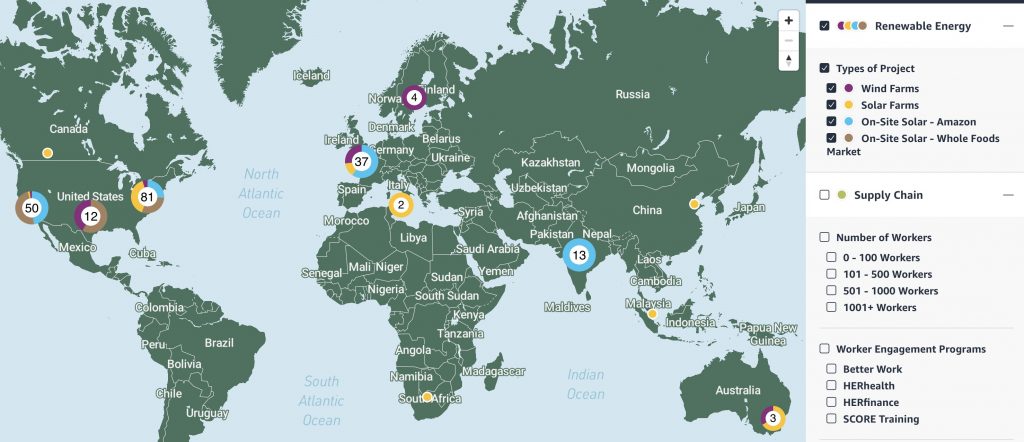
Technology and The Virtual Reality Future
From AWS software, blockchain, countless virtual reality and other software applications, to augmented reality shopping experiences and gaming pleasures, Amazon is staying ahead of the curve to entice, seduce, and fold you into their futuristic smart cities, where taking a vacation means putting on eyewear. They want “smart” devices in your homes, in your hands, and even inside your body and mind. They want you “hooked in,” and they are not the only ones. The future of AI and transhumanism for the fourth industrial revolution is something they have been programming you for and marching in for a long time now.
What Are Some Ways You Can Navigate Around or Through This Impending Takeover?
Some of this may feel like fun and games, new exciting technology, oooo virtual reality, modern conveniences, tech that does everything for you so you can save time and be lazy, and so handy to have a drone deliver your goods in 30 minutes – until you wake up one day and realize you are so plugged in, you are no longer making decisions, have any choices, your privacy is gone, your travel doesn’t consist of leaving town, you are spied on in your own home, you begin to feel like a robot taking orders, have lost your true identity, and are no longer living a life, but rather an illusion – a very dystopian one at that. The programming, conditioning, and addictions they have carefully constructed within humanity is staggering.
They are slowly stripping away your spirit, your soul, and your livelihood to hook you into the largest operating system in the world to integrate you into an AI system to the point of no return, and everyone has allowed this to happen. It’s called self-enslavement, and it’s time to cut the cord.
• First and foremost, minimize your exposure to technology, remove “smart” devices, and be ultra observant of your surroundings and environment. I recently wrote a checklist on how to protect yourself by minimizing exposure to technology and mind control for Catherine Austin Fitts’ Quarterly Wrap-Up. If you are a subscriber of hers, be sure to check it out. If not, I will be republishing it on Corey’s Digs in late May, along with a video discussion between Catherine and myself. If you would like access to my checklist article prior to then, consider becoming a Patron and supporting my work, where you can access it today.
• Remove your technology footprint to the best of your ability. Use a VPN when surfing the internet and shopping, use encrypted email such as Protonmail, limit the amount of sites you are providing your phone number and full contact information to.
• Stop shopping at Amazon, Whole Foods, or their Fresh Markets. Shop at your smaller local grocery and retail stores, and support your local farmers – they are our future. If you are in the hospitality industry and use smaller scale foodservice distributors, have a conversation with them about the direction things are headed and support them. Or, if you use a bigger distributor ask them about any recent changes or what they foresee coming down the pike.
• Pull your money out of big centralized banks and put it into a small, local bank. This is the single biggest thing that would have an enormous impact if millions of people did this.
• If you are considering investing in any of these nefarious industries to make a quick buck, consider that you are feeding the beast that is creating our future enslavement. Is it worth it?
• Where you live and the community of people who reside there is going to dictate a lot about your future, how quickly these advances on your city may emerge, and the ability to put a halt to it. This is an extensive project I’ve been working on and will be rolling out in the weeks to come. It will likely be an ongoing project and will have invaluable information.
• Unfortunately, digital currency is here and eventually they will do away with the dollar. Groups of intelligent people need to have a meeting of the minds and quickly begin working on other forms of a monetary system that operates outside of the system they control. Any form of digital currency technically is operating under their system and framework. Trade and barter will be important, but a monetary system will be needed as well.
• Build up your skills in gardening, farming, and trades. Trade schools will be far more important than a college education.
• Follow legislation regarding autonomous vehicles and transportation, digital currency, farming and agriculture, vaccine tracking and/or mandates, and housing, to stay on top of it and contact your reps either opposing or supporting the legislation, pending what it entails. Do not negate this as a futile effort, as there have been a lot of negative legislation stopped by these efforts, as well as some put in place.
• Share this information far and wide so all Amazon shoppers understand the magnitude of the situation and the future we are creating for ourselves.
• Keep your chin up. Do not feel defeated. We ultimately did this to ourselves and we have the ability to undo it. Stop feeding the beast and buying into their “conveniences.”













